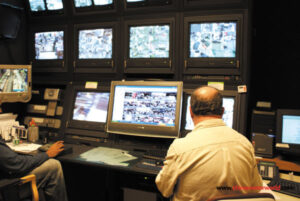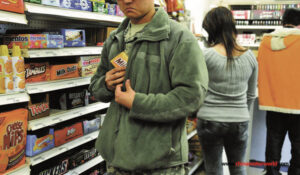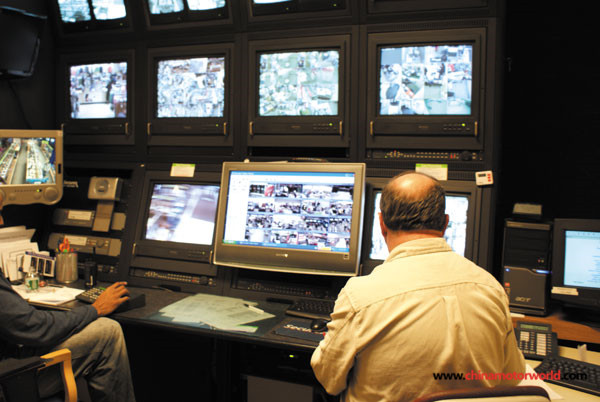Shoplifting is a huge problem in the USA, and around the world. In the USA the cost is estimated at $25,000,000 per day!!! That’s huge. How can you prevent this from happening in your store? Below, we discuss many ways to look for the behavior of thief’s, and what to do when found out.
First-Spot the Shoplifter
Unfortunately, there is no typical profile of a shoplifter. Thieves come in all ages, races and from various backgrounds. However, there are some signs that should signal a red flag for retailers. While the following characteristics don’t necessarily mean guilt, retailers should keep a close eye on shoppers who exhibit the following:
- Spends more time watching the cashier, sales clerk, or cameras, than actually shopping.
- Wears bulky or heavy clothing during warm weather, or baggy coats when unnecessary.
- Walks with short or unnatural steps, which may indicate that they are concealing heavy or clumsy lifted items in their clothing.
- Takes several items into dressing room and only leaves with one item or none at all.
- Seems nervous and possibly picks up random items with no interest.
- Often shoplifters are on drugs or alcohol, and have jerky, fast, paranoid, or odd movements.
- Frequently enters store, and never makes a purchase.
- Large groups entering the store at one time, especially juveniles. A member of the group causes a disturbance to distract sales staff.
- Large groups of say 5 customers come in, and spread out in separate directions. The problem begins when you have just 2 or 3 available employees to follow them. 2 or 3 members of the group will not be watched, and can fill their pockets and jackets.
Employee Phony Shoppers
One way to defend against shoplifters is to place individuals throughout the store who act as regular customers — but are actually there to keep an eye on other shoppers. Shoplifters will be more wary of store employees, but usually don’t pay much attention to people acting as if they’re also there to shop. The “phony” shoppers should appear as customers, not looking around too much as this is cause for suspicion. They should use dressing rooms, collect items throughout the store, and be good enough actors to portray a traditional shopper, while still keeping an eye out for potential shoplifting behavior.
Use Uniform Security Guards
Not only can uniform security guards prevent a shoplifter from stealing goods from the store and making it to their vehicle, but just having security guards visibly in or near the store may deter thief’s from entering your retail store. People are much less likely to attempt shoplifting when they see that is more likely they will not get away with it. The uniform security guards should be trained in what to look for when identifying shoplifters, as some states have laws against stopping an individual before they actually leave the store with the goods.

Post Signs
Another way to deter shoplifters is to place signs throughout your store that state exactly what the penalty are for shoplifting. You should place these signs on the front entrance door, in dressing rooms, and various other places throughout your store. It is a great low priced defense against shoplifting.
Perform Exit Inspection
If you have had a problem with shoplifters, you can prevent future occurrences by performing exit inspection. While you can’t look through someone’s personal belongings, you can require them to show a receipt for what is in their shopping bag. This prevents shoplifting by individuals that put in more items in their bag than what they purchased. It also helps to design a floor plan to have 1 way in, and 1 way out of a store department. Like a security funnel.

Use Surveillance Technology
Having surveillance technology will help you to prevent shoplifting from occurring and decrease your loss astronomically. Place video surveillance equipment throughout your store so that most if not all of your store is covered by the cameras. Don’t hide them, because knowing they are being watched can also deter shoplifting from stealing from your store. Train security personnel to view the cameras and look for suspicious behavior.
As a store owner, small business retail loss prevention is an important part of doing business. When individuals steal goods or money from your store, it has a large impact on your business finances and cause tremendous burden on your business overall. You should also purchase adequate business insurance for the cases when preventing shoplifting was not possible.
Greet all customers on their way into the store, and let them know someone will be near them at all times in case they need help. Approach any suspicious person and ask if he/she is finding everything okay. Make the shoplifters feel watched.
Code 3: If you notice suspicious activities, alert other employees immediately. Many stores have a security code to alert staff of possible shoplifters. Come up with your own special word for the store speaker system like “Code 3”, or “Peanut”. Customers will have no idea what these words mean, but all the employees and security will know.
Many stores designate specific areas of the store with numbers so other employees know where to go. Like the parts dept of a motorcycle store can be area 1. Sales floor can be area 2. Riding gear dept can be area 3 and so on. So…. If it was announced over the store speakers…. “Peanut in area 1”. Only your employees would know there is a shoplifter or thief in the parts dept.
Caught Thieves:
In each country, or state, laws vary on what to do with thieves when caught. In some countries it is not allowed to put your hands on them, even though they are clearly criminals. In some countries you may be able to Pepper Spray, or beat the criminals, and then tie them up for the police. You need to check with your local law enforcement to find out your local laws.

